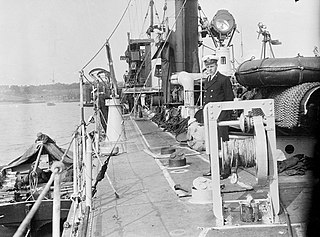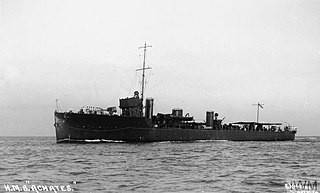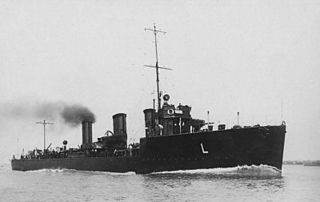HMS Sceptre was an R-class destroyer of the Royal Navy, built by Alexander Stephen and Sons, at Linthouse and launched on 18 April 1917. In total 51 ships were in this class and saw service in World War I, entering service from 1916 to 1917 and suffering comparatively light losses. Sceptre saw action as part of the Harwich Force, operating mainly in the North Sea. She survived the war and was sold for disposal in 1926.

The first HMS Zulu was a Tribal class destroyer launched 16 September 1909 at Hawthorn Leslie Shipyard and commissioned in March 1910. She was mined during the First World War, on 27 October 1916 off Dover in a minefield lain by the Imperial German submarine UC-1. Her stern was blown off and sank, but the forward section remained afloat. It was towed into port and attached to the stern of Nubian, which had been torpedoed, to form a new destroyer named HMS Zubian.

HMS Laforey was the lead ship of her class of destroyer built for the Royal Navy. Launched a year before the First World War began, she was attached to the Dover Patrol. Laforey saw action in several engagements with German torpedo boats, including the Battle off Noordhinder Bank and the action of 17 March 1917. Laforey was sunk in 1917 by a British mine after escorting several freighters to France. She was named for Francis Laforey, captain of HMS Spartiate at the Battle of Trafalgar in 1805.
Chios was a Medea-class destroyer laid down for the Greek Navy by Fairfield Shipbuilding and Engineering Company, Govan in 1914. She was launched as 16 December 1914 and completed for service in the Royal Navy as HMS Melampus on 29 June 1915. On 16 April 1917 she accidentally rammed and sank the C-class submarine C16. She was sold for breaking up on 22 September 1921.
HMS Ophelia was an Admiralty M-class destroyer built for the Royal Navy during the First World War, entering service in 1916. The ship served at the Battle of Jutland on 31 May/1 June 1916, and sank a German submarine in 1918. She was sold for scrap in 1921.
HMS Leven was a Fairfield "30-knotter" destroyer of the Royal Navy, later classified as part of the C class. It was built in 1898–1899, and served with the Royal Navy through to the First World War, sinking a German U-boat in 1918. Leven was sold for scrapping in 1920.
HMS Ouse was a Laird type River-class destroyer ordered by the Royal Navy under the 1903 – 1904 Naval Estimates. Named after the River Ouse in north east England near the city of York, she was the first ship to carry this name in the Royal Navy.
HMS Laverock was a Laforey-class destroyer of the Royal Navy. She was launched in 1913 and entered service in October 1914. Laverock served through the First World War, operating with the Harwich Force and in the English Channel. She was sold for scrap in 1921.
HMS Murray was a Royal Navy Admiralty M-class destroyer. Ordered before the outbreak of war, she was therefore the first of her class to enter operation during the early months of the First World War. She was also the first vessel of the Royal Navy to carry the name HMS Murray.

HMS Torrent was a Royal Navy R-class destroyer constructed and then operational in the First World War. She was sunk, with most of her crew in 1917. On 23 December 1917 Surprise, HMS Torrent, and Tornado sank after entering an Imperial German minefield.

HMS Retriever was a Thornycroft-built R-class destroyer which served with the Royal Navy during the First World War. Launched in 1917, the vessel formed part of the Harwich Force and took part in operations off the coast of Ostend in support of the bombardment of the town in June that year. During August the following year, the vessel attempted to deploy a seaplane from a towed lighter, but a lack of wind meant the operation was unsuccessful. The vessel was also jointly credited with the destruction of the submarine SM UB-54 that year, although this has been disputed. After the war, the ship was placed in reserve and was sold to be broken up in 1927.

HMS Thruster was an R-class destroyer which served with the Royal Navy during the First World War. The R class were an improvement on the previous M class with geared steam turbines to improve efficiency. Built by Hawthorn Leslie and launched in January 1917, Thruster joined the Harwich Force, serving as part of a flotilla that escorted the monitors Erebus and Terror in their bombardment of Ostend in June that year. During the following month, Thruster, along with sister ship Springbok, captured the two German merchant ships SS Brietzig and SS Pellworm. The destroyer was also jointly credited with sinking the submarine UB-54 the following year. After the signing of the Armistice that ended the war, the destroyer was allocated to anti-submarine research and helped in the development of anti-submarine tactics with ASDIC. In April 1928, the ship took part in a high-speed demonstration for the King of Afghanistan, the Amanullah Khan, and, in January 1932, participated in the unsuccessful search for the crew of the submarine M2. Placed in reserve at the Nore in June 1936, Thruster was sold to be broken up in March 1937.

HMS Manly was a Yarrow M-class destroyer of the British Royal Navy. Built by the Scottish shipbuilder Yarrow between 1913 and 1914, Manly served during the First World War. She formed part of the Harwich Force in the early years of the war, and then later in the English Channel as part of the Dover Patrol taking part in the Zeebrugge Raid in 1918. She survived the war, and was sold for scrap in 1920.

HMS Landrail was a Laforey-class destroyer of the British Royal Navy. The Laforey class was the class of destroyers ordered under the Royal Navy's 1912–1913 construction programme, which were armed with three 4-inch (102 mm) guns and four torpedo tubes and were capable of 29 knots. The ship, which was originally to be named Hotspur but was renamed before launch, was built by the Scottish shipbuilder Yarrow between 1912 and 1914,

HMS Achates was an Acasta -class destroyer of the British Royal Navy. She was built by the Scottish shipbuilder John Brown and was built between 1912 and 1913. Like all Acasta-class destroyers, Achates was armed with three 4-inch (102 mm) guns and two torpedo tubes, with a specified speed of 29 knots.
HMS Milne was a Royal Navy Admiralty M-class destroyer. Milne was built by John Brown & Company from 1913 to 1914 and was completed in December that year. She served through the remainder of the First World War, at first with the Harwich Force with which she took part in the Battle of Dogger Bank in January 1915, and later with the Dover Patrol, sinking the German submarine UC-26 in May 1917. Milne was sold for scrap in 1921.
HMS Spenser was a Thornycroft type flotilla leader of the British Royal Navy. She was built by J I Thornycroft from 1916 to 1917 as the lead ship of her class, launching in September 1917 and completing in December that year.

HMS Llewellyn was a Laforey-class destroyer that served with the Royal Navy. Laid down on 14 December 1912 as HMS Picton, the ship was renamed on 30 September 1913 under an Admiralty order to become one of the first alphabetical class destroyers, being launched on 30 October. On commissioning, the vessel joined the Third Destroyer Flotilla and operated as part of the Harwich Force during the First World War. The destroyer took part in the Battle of Heligoland Bight, as well as undertaking anti-submarine patrols and escort duties. It was during one of these patrols on 4 December 1916 that the vessel unsuccessfully attacked the German submarine UB-18. On 17 March 1917, the destroyer was struck in the bow by a torpedo launched by a German torpedo boat while rescuing survivors from the sunk destroyer Paragon, but returned to port safely by steaming backwards. With the cessation of hostilities, the ship was placed in reserve. Although subsequently offered for sale to the Finnish Navy, Llewellyn was instead withdrawn from service and sold to be broken up on 18 March 1922.

HMS Lawford was a Laforey-class destroyer of the British Royal Navy. The Laforey class was the class of destroyers ordered under the Royal Navy's 1912–1913 construction programme, which were armed with three 4-inch (102 mm) guns and four torpedo tubes and were capable of 29 knots. The ship, which was originally to be named Ivanhoe but was renamed before launch, was built by the Scottish shipbuilder Fairfields between 1912 and 1914.

HMS Pigeon was an Admiralty M-class destroyer which served with the Royal Navy during the First World War. The M class were an improvement on the previous L-class destroyer, capable of higher speed. Launched on 3 March 1916 by Hawthorn Leslie on the River Tyne, the vessel served as part of the Grand Fleet. Pigeon was mainly involved in escorting convoys. After an unsuccessful sortie in October 1917 against German cruisers, the destroyer moved to anti-submarine warfare. In this arena, Pigeon had some success in 1918, rescuing the survivors from the sinking troopship Tuscania in February and assisting in the destruction of the German U-boat UB-124 in July. After the Armistice, the destroyer was redeployed to serve as part of the Nore Local Defence flotilla until being decommissioned and sold to be broken up on 9 May 1921.










